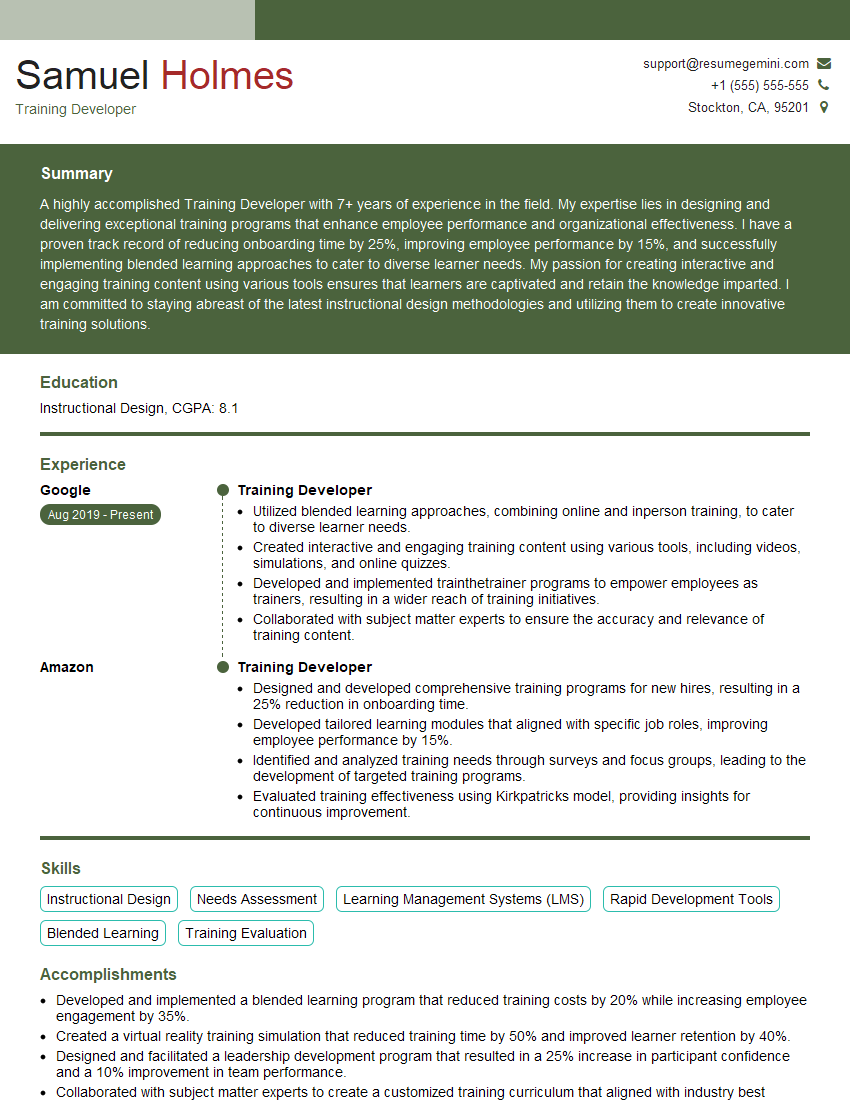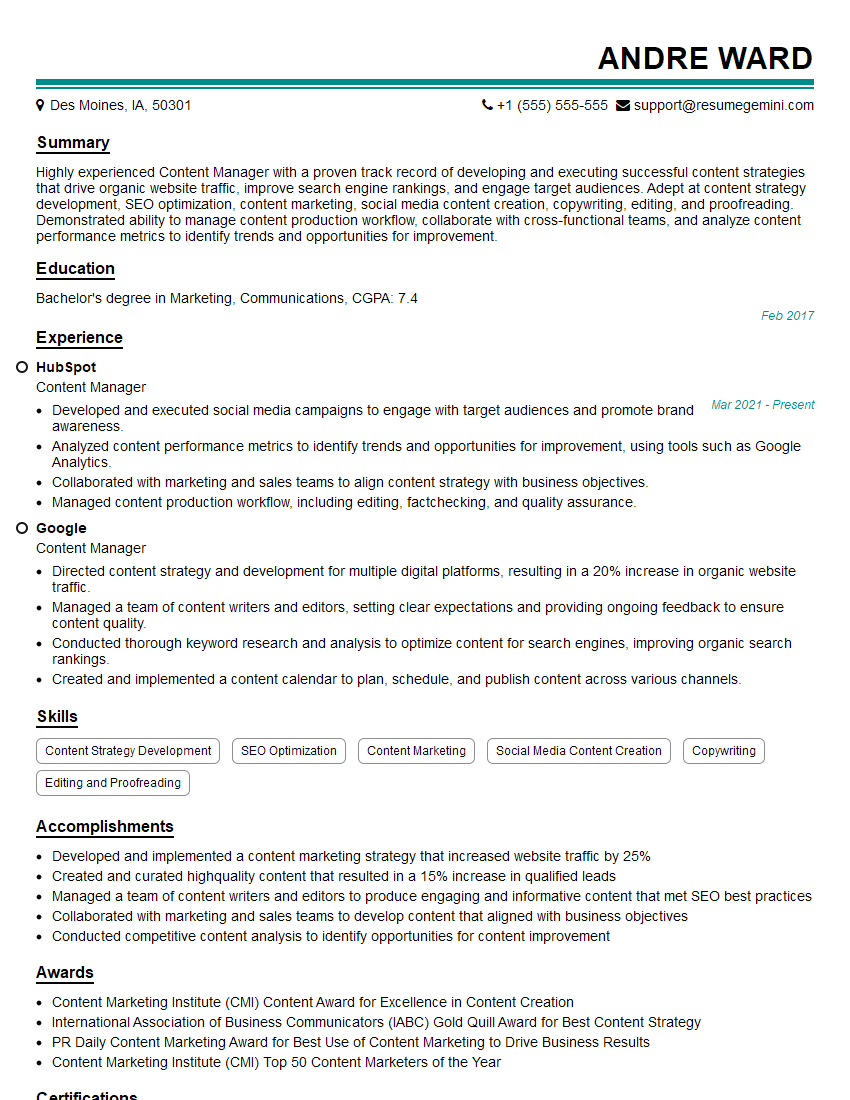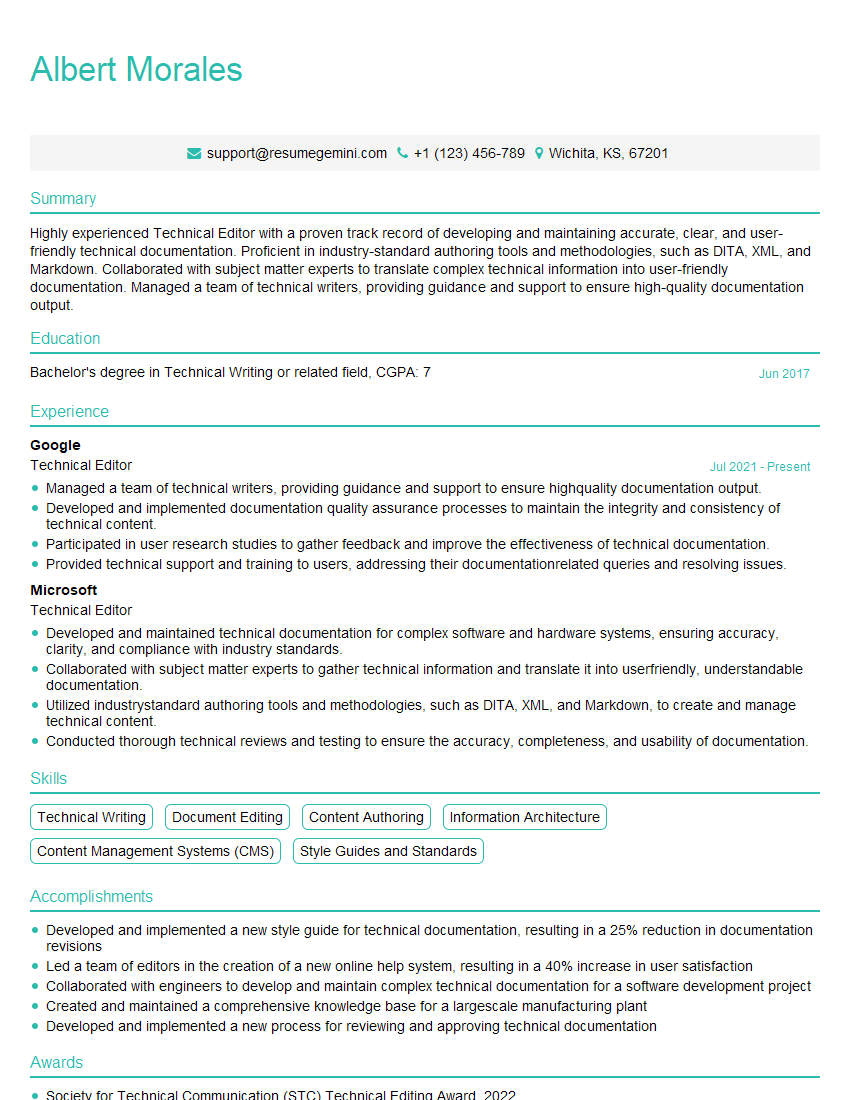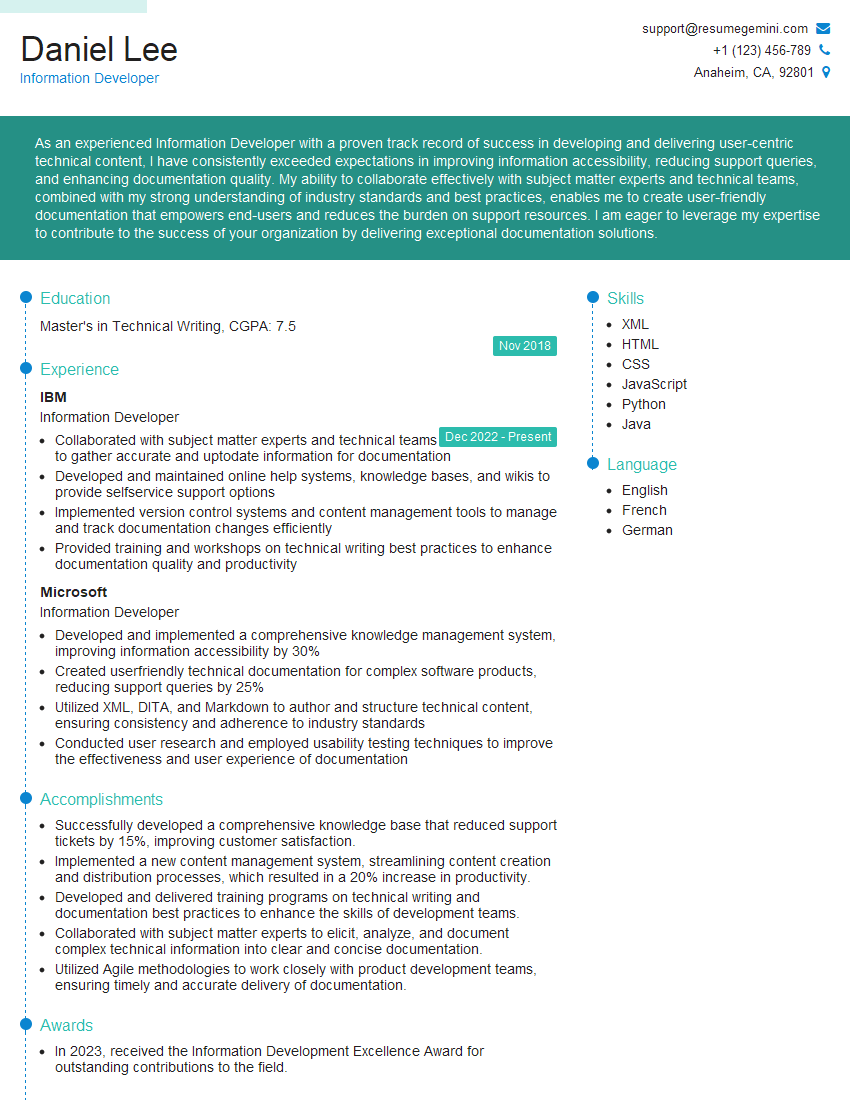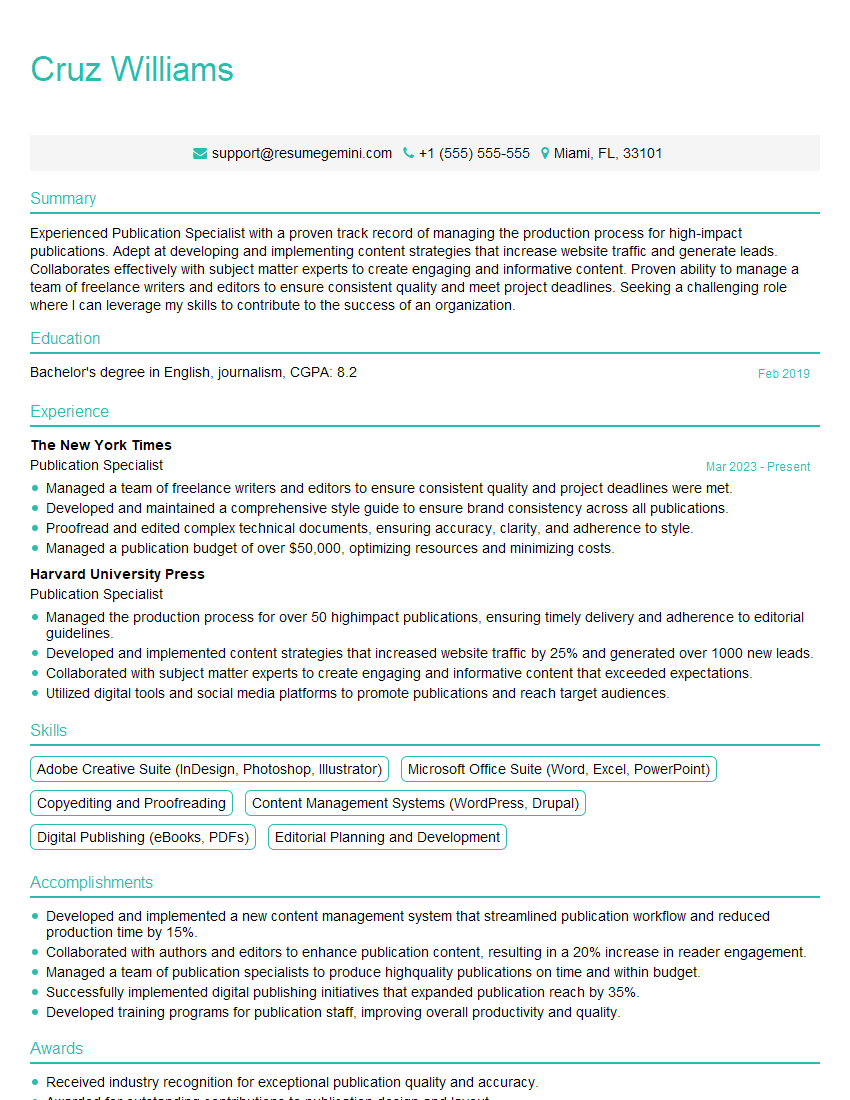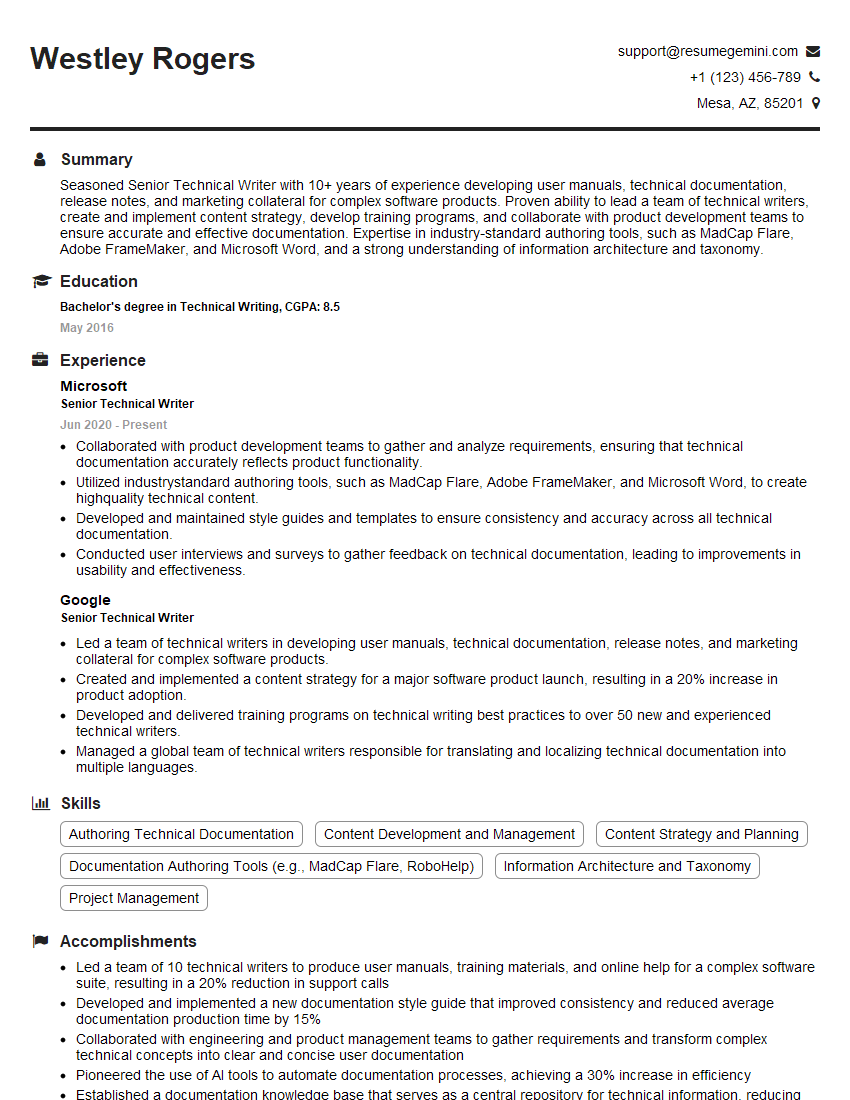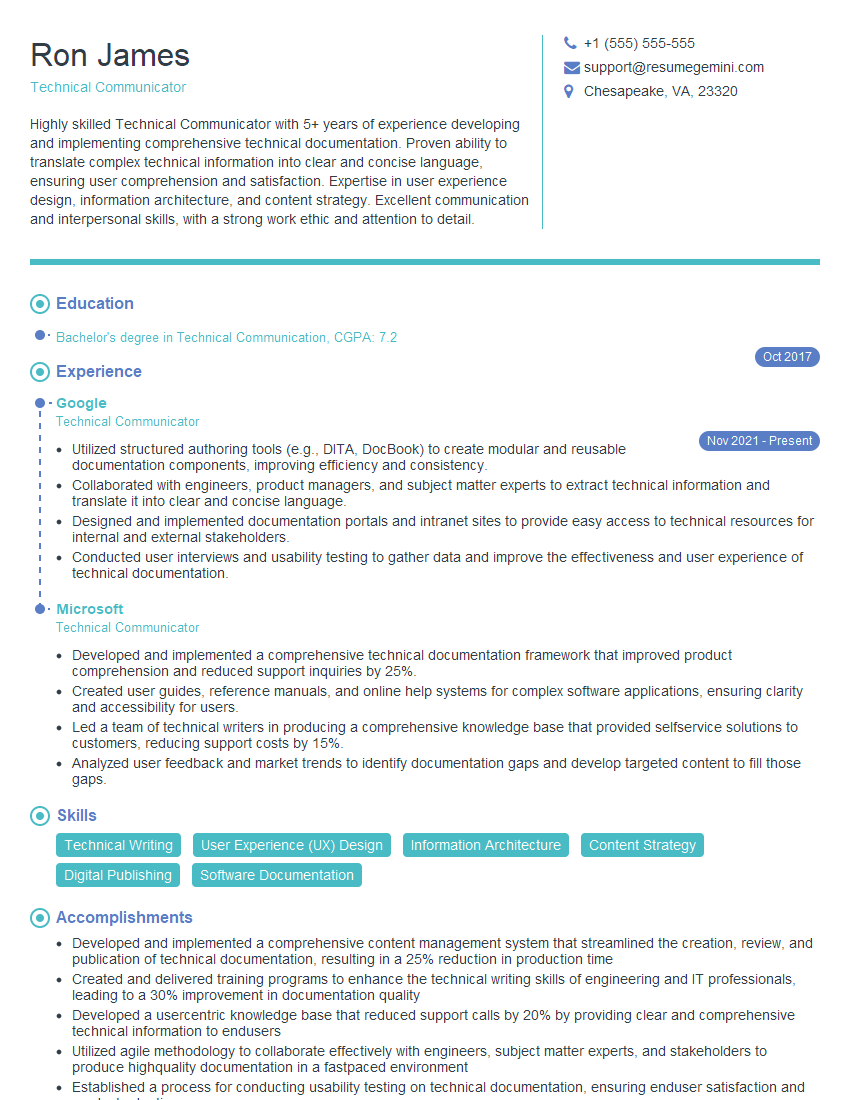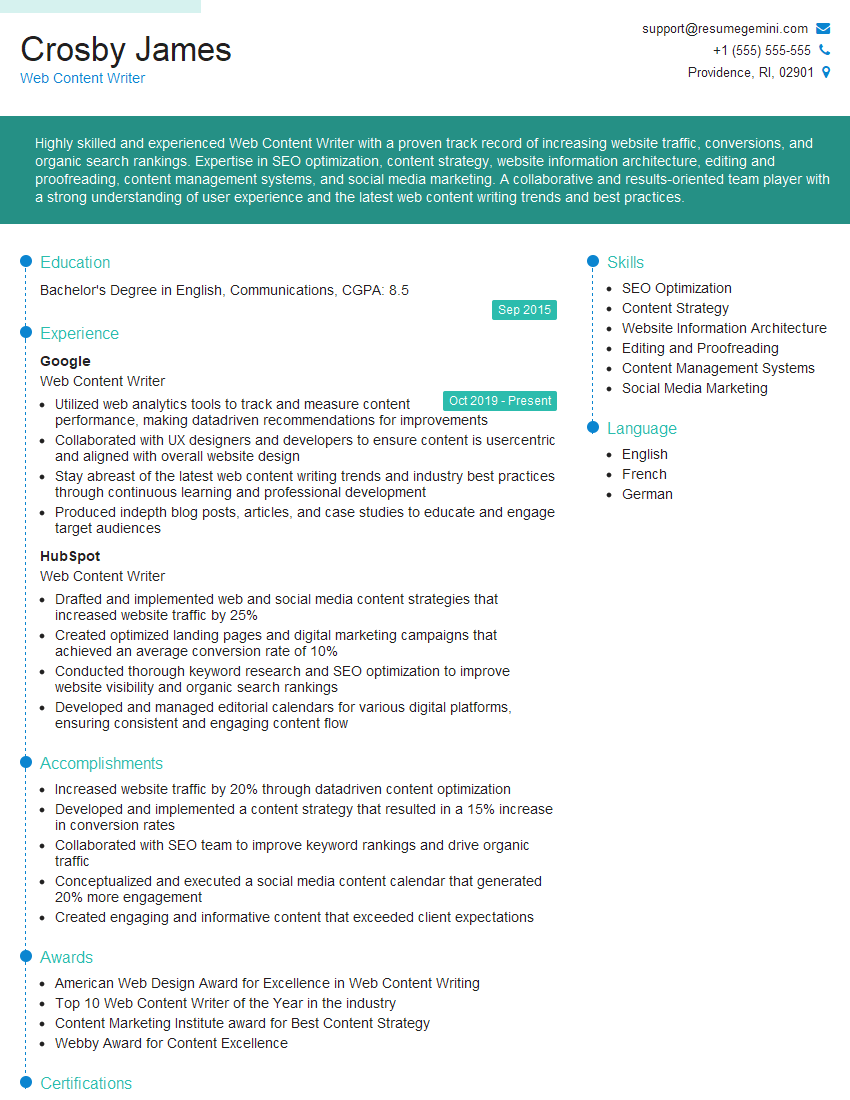The thought of an interview can be nerve-wracking, but the right preparation can make all the difference. Explore this comprehensive guide to Proper Documentation interview questions and gain the confidence you need to showcase your abilities and secure the role.
Questions Asked in Proper Documentation Interview
Q 1. Explain the importance of using a style guide for documentation.
A style guide is the cornerstone of consistent, high-quality documentation. Think of it as a grammar and style guide, but for your technical writing. It ensures uniformity across all your documents, making them easier to read, understand, and maintain. Without a style guide, you risk a chaotic mess of different formatting, terminology, and writing styles, confusing your audience and hindering knowledge transfer.
A comprehensive style guide typically covers aspects such as:
- Voice and Tone: Should the documentation be formal or informal? Technical or accessible to a broader audience?
- Terminology: Defines consistent terms and abbreviations. For example, specifying that ‘UI’ always means ‘User Interface’, not ‘User Input’.
- Formatting: Specifies rules for headings, lists, code blocks, tables, and images, ensuring visual consistency.
- Grammar and Punctuation: Addresses specific grammatical conventions and punctuation styles.
- Example Styles: Showcasing examples of properly formatted code, tables, and other elements.
Imagine trying to assemble IKEA furniture without instructions. A well-defined style guide provides that crucial instruction manual for your documentation, ensuring a seamless and easily digestible user experience.
Q 2. Describe your experience with different documentation formats (e.g., PDF, HTML, Wiki).
I have extensive experience with various documentation formats, each suited to different needs. PDFs offer a static, printable format ideal for archival purposes and offline access. However, they lack the interactivity and searchability of other formats. HTML, on the other hand, provides dynamic content, easy navigation through hyperlinks, and superior searchability. This makes it suitable for online help systems and web-based documentation. I’ve extensively utilized HTML and CSS to create responsive and visually appealing documentation, ensuring accessibility across different devices.
Wikis offer a collaborative platform perfect for evolving documentation. Their version control feature allows for tracking changes and easy collaboration among multiple authors, ideal for large projects. I’ve used wikis extensively for internal documentation where frequent updates and collaborative editing are required. For instance, during a project involving a complex software system, we used a wiki to consolidate user feedback, troubleshooting tips, and feature updates, ensuring the documentation always mirrored the latest state of the software.
Q 3. How do you ensure consistency and accuracy in your documentation?
Maintaining consistency and accuracy is paramount. My approach involves a multi-pronged strategy. First, I meticulously use a style guide (as discussed earlier). Then, I implement rigorous review processes. This includes peer reviews and testing by end-users to identify gaps, ambiguities, and inaccuracies. Version control systems like Git are essential for tracking changes, allowing for easy rollback if needed and providing a clear audit trail of modifications.
For accuracy, I cross-reference information with source code, database schemas, and other authoritative sources, ensuring the documentation aligns perfectly with the product or system it describes. Regular updates are crucial, ensuring the documentation stays current with any changes. Automated testing can be used to check for broken links or inconsistencies where feasible. Finally, establishing a feedback loop with users allows for continuous improvement based on real-world usage.
Q 4. What tools and technologies are you familiar with for creating and managing documentation?
My toolkit includes a range of tools. For authoring, I’m proficient in Markdown, a lightweight markup language, which allows for easy collaboration and version control, often using editors like VS Code or Typora. I’m also experienced with various authoring tools like MadCap Flare and RoboHelp for more structured documentation. For managing and publishing, I utilize Git for version control, ensuring easy collaboration and tracking changes. For hosting, I’ve used platforms such as GitHub Pages, GitLab Pages, and various Content Management Systems (CMS).
Additionally, I am adept at using tools for creating diagrams (draw.io, Lucidchart), generating API documentation (Swagger), and screen recording software for creating video tutorials, depending on the project’s needs. My experience extends to using cloud-based solutions for storage and collaboration.
Q 5. How do you handle conflicting feedback from multiple stakeholders?
Conflicting feedback is inevitable in collaborative projects. My approach involves active listening and seeking to understand the underlying concerns of each stakeholder. I facilitate discussions to identify areas of common ground and highlight potential compromises. Documentation is often a collaborative effort, and a balanced approach will ensure the final product benefits everyone.
I document all feedback, including the source and rationale, making transparent the decision-making process. Prioritization is key, focusing on addressing critical issues that significantly impact user understanding or accuracy first. When compromises are necessary, clear explanations justify the chosen direction, ensuring transparency and preventing future conflicts.
Q 6. Describe your process for creating user manuals.
Creating user manuals involves a structured approach starting with thorough needs analysis. I identify the target audience’s technical expertise and their expected interactions with the product. This shapes the tone, complexity, and structure of the manual. Next, I plan the content, outlining the key tasks users will perform and the steps needed to accomplish them. This could include task-based walkthroughs, tutorials, troubleshooting sections, and FAQs.
I then proceed with writing the content, ensuring it’s clear, concise, and easy to follow. I utilize visuals such as screenshots and diagrams to enhance understanding. A thorough review process (peer review and testing) is essential to identify errors or areas needing improvement before the final release. Throughout the entire process, I use a consistent style guide, ensuring consistency in formatting and terminology.
Q 7. How do you prioritize features to include in documentation?
Prioritization depends on the user needs and product features’ criticality. Features vital for completing core tasks or frequently used functionalities take precedence. I analyze user workflows and identify pain points; addressing these in the documentation first improves user experience. Features with higher complexity or potential for user error also warrant early inclusion.
A simple prioritization matrix can be helpful, ranking features by both their importance to the user and the frequency of their usage. Features crucial to success and frequent use receive highest priority. While less critical features are included, their inclusion may be deferred to future releases or incorporated as supplementary materials, ensuring the primary documentation focuses on crucial information.
Q 8. How do you manage updates and revisions to existing documentation?
Managing updates and revisions to documentation requires a structured approach. Think of it like maintaining a living document that constantly evolves. I typically use a version control system (like Git) to track changes, allowing for easy rollback if needed. A clear revision process is crucial. This involves designating a single source of truth (e.g., a central repository) and establishing a workflow for proposing, reviewing, and approving changes.
For example, if a user reports an error in a procedure, I create a new branch in Git, make the correction, and submit a pull request for review by other team members before merging it into the main branch. This ensures quality control and maintains a history of all modifications. Clear version numbers and change logs are also essential for users to understand what’s been updated and when.
Furthermore, I advocate for using a robust documentation platform that supports collaborative editing and versioning. This allows multiple authors to contribute efficiently, while maintaining a unified and consistent document. A clear communication plan ensures everyone involved knows the update process, deadlines and responsibilities. This might involve regular team meetings or email updates.
Q 9. Explain your approach to creating effective visuals for technical documentation.
Effective visuals are critical for clear and concise technical documentation. They shouldn’t just be pretty; they should enhance understanding. I strive to create visuals that are simple, consistent, and relevant to the content.
My approach includes a variety of techniques. For example, when explaining a complex process, I might use a flowchart to illustrate the steps involved. For showing the layout of a system, I’d create a clear diagram. Screenshots are invaluable for demonstrating software interfaces, but I always annotate them to highlight important elements. Tables are excellent for comparing features or displaying data concisely.
Consistency is key. I adhere to a defined style guide for visuals, ensuring consistent use of colors, fonts, and image sizes throughout the documentation. Accessibility is also a priority. I use sufficient color contrast, avoid overly complex graphics, and provide alternative text for all images for users with visual impairments. Finally, I always get feedback on my visuals to ensure clarity and effectiveness before publishing.
Q 10. How do you incorporate user feedback into your documentation process?
User feedback is invaluable for improving documentation. I actively solicit feedback through various channels. This might involve embedding feedback forms within the documentation itself, using survey tools, or conducting user interviews.
When I receive feedback, I categorize it (e.g., clarity issues, accuracy problems, missing information). This allows me to prioritize improvements based on their impact and frequency. I use a ticketing system to track and manage feedback, ensuring each issue is addressed appropriately.
For example, if multiple users report confusion about a specific section, I’ll revise that section to improve clarity, perhaps adding more visuals or simplifying the language. I always acknowledge feedback, even if I can’t immediately implement a suggested change, demonstrating responsiveness and fostering a collaborative relationship with users.
Q 11. How do you ensure your documentation is accessible to all users?
Accessibility is paramount. My goal is to make documentation usable by everyone, regardless of their abilities. I follow established accessibility guidelines, such as WCAG (Web Content Accessibility Guidelines).
This involves using clear and concise language, avoiding jargon whenever possible, and ensuring sufficient color contrast between text and background. All images need descriptive alternative text. I structure the document logically with clear headings and subheadings, using lists and bullet points to break up large chunks of text. I also ensure the document is compatible with screen readers and other assistive technologies.
For example, I use semantic HTML tags such as <h1>, <h2>, <ul>, and <li> to structure content logically. I provide transcripts for videos and captions for audio content. Regularly testing the documentation with assistive technologies ensures that it truly is accessible to all users.
Q 12. Describe your experience with version control systems for documentation.
Version control systems are essential for managing documentation. Git is my go-to system, and I have extensive experience with its branching, merging, and commit features. This allows me to track changes, collaborate with others, and revert to previous versions if necessary.
I’m familiar with platforms like GitHub and GitLab, which provide features for code review and collaborative editing of documentation. Using a branch-based workflow prevents accidental overwriting of important content. Each update or modification is made on a separate branch, allowing for thorough review before merging it into the main branch. This ensures that all changes are well documented and trackable.
Beyond the technical aspects, using a version control system promotes good documentation practices and collaboration. This is reflected in the ability to easily review and comment on changes and track changes from different individuals efficiently. This collaborative and documented approach contributes significantly to quality assurance.
Q 13. How do you ensure your documentation is SEO-friendly?
SEO-friendly documentation ensures it’s easily discoverable by search engines. I employ several strategies to achieve this.
First, I conduct keyword research to identify terms users are likely to search for when looking for information related to the product or service the documentation covers. I then incorporate these keywords naturally into the document’s title, headings, and body text. I also optimize images with descriptive alt text containing relevant keywords.
Furthermore, I use clear and concise language and structure the document logically to improve readability and search engine ranking. Internal linking between relevant sections is critical; this helps users navigate the documentation and signals to search engines the relationship between different pages. I also ensure the documentation is easily shareable on social media platforms by creating compelling summaries and utilizing social media tags. The use of a sitemap and a robots.txt file is crucial for directing search engine crawlers to the relevant documentation pages.
Q 14. What metrics do you use to measure the effectiveness of your documentation?
Measuring the effectiveness of documentation involves tracking several metrics. Simply creating the documentation isn’t enough; we need data to show its value.
Key metrics include:
- Search and Help Desk Tickets: A decrease in these indicates improved clarity and accessibility, allowing users to resolve issues independently.
- User Feedback: Positive feedback and high user satisfaction scores reflect well-received and helpful documentation.
- Website Analytics: Tracking page views, time spent on pages, and bounce rates can reveal areas for improvement.
- Customer Satisfaction (CSAT) Surveys: Gauging user satisfaction with their experience using the documentation.
- Completion Rate of Tutorials/Guides: Measures if users successfully follow complex procedures.
By consistently monitoring these metrics, I can identify areas needing improvement and make data-driven decisions to enhance the documentation’s effectiveness. This iterative approach ensures documentation continually meets user needs and contributes to overall product or service success.
Q 15. How do you handle documentation for complex or rapidly changing systems?
Handling documentation for complex or rapidly changing systems requires a strategic approach that prioritizes flexibility and maintainability. Think of it like building with LEGOs – you need a system that allows for easy additions, modifications, and even dismantling of parts without collapsing the whole structure.
Version Control: Employing a robust version control system (like Git) is crucial. This allows for tracking changes, reverting to previous versions if needed, and collaborating effectively with multiple authors. For instance, if a new feature is added, we can create a new branch, document it thoroughly, and merge it back into the main branch once tested. This prevents chaos and ensures everyone is working with the latest accurate information.
Modular Documentation: Breaking down the documentation into smaller, independent modules (e.g., by feature or component) makes it easier to update specific sections without impacting the entire document set. Imagine a complex software with many modules. Updating documentation for one module shouldn’t require rewriting the entire user manual.
Agile Documentation Practices: Adopting agile methodologies ensures documentation keeps pace with development. This includes frequent updates, close collaboration with developers, and iterative refinement based on user feedback. Regular sprints with defined documentation tasks ensure documentation is always relevant.
Automated Build Processes: Automating the documentation build process (using tools like Sphinx or MkDocs) helps in streamlining updates and ensuring consistency across all versions. This eliminates manual steps and reduces errors.
Continuous Integration/Continuous Delivery (CI/CD): Integrating documentation updates into the CI/CD pipeline guarantees that updated documentation is deployed alongside new software releases. This maintains consistency and provides users with the most up-to-date information.
Career Expert Tips:
- Ace those interviews! Prepare effectively by reviewing the Top 50 Most Common Interview Questions on ResumeGemini.
- Navigate your job search with confidence! Explore a wide range of Career Tips on ResumeGemini. Learn about common challenges and recommendations to overcome them.
- Craft the perfect resume! Master the Art of Resume Writing with ResumeGemini’s guide. Showcase your unique qualifications and achievements effectively.
- Don’t miss out on holiday savings! Build your dream resume with ResumeGemini’s ATS optimized templates.
Q 16. Describe your experience with single-sourcing and content reuse.
Single-sourcing and content reuse are cornerstones of efficient documentation. Think of it like having a master recipe that you can adapt for different dishes. It minimizes redundancy, ensures consistency, and simplifies updates.
Single-sourcing means storing all content in a central repository, eliminating duplicated information. Instead of having multiple versions of the same instruction scattered across different documents, it’s all in one place. For example, a description of a specific feature would be written once and reused across the user manual, the API reference, and the FAQ section.
Content reuse leverages this centralized repository, allowing components to be reused across multiple documents. This not only saves time and effort but also guarantees consistency. If a change is needed, it only needs to be made in one place, updating all the documents where that component is used.
Practical Example: In a previous role, we used a component content management system (CCMS) to manage our documentation. We created reusable components such as ‘installation instructions,’ ‘troubleshooting steps,’ and ‘feature descriptions,’ which were then integrated into various manuals and tutorials. When changes were required, we made edits to the components in the central repository, automatically updating all relevant documents.
Q 17. How familiar are you with DITA or other XML-based authoring tools?
I’m very familiar with DITA (Darwin Information Typing Architecture) and other XML-based authoring tools. DITA is a powerful standard for structuring information, enabling modularity, reusability, and multi-channel publishing. XML’s inherent structure allows for easy manipulation, transformation, and management of content.
DITA’s benefits: Its structured nature allows for the creation of modular content that can be easily reused in various contexts (e.g., online help, printed manuals, mobile apps). The separation of content from presentation allows for a single source of truth, adaptable to different output formats.
Tools: I have experience using various DITA editors like Oxygen XML Editor and tools such as Adobe FrameMaker for both DITA and other XML-based authoring workflows. These tools simplify content creation, validation, and transformation.
Example: In a previous project, we used DITA to create a large-scale technical documentation set. We organized information into topics, maps, and specialized DITA elements. This modular approach allowed us to easily update individual components without affecting others, and to tailor the documentation to different audiences (developers, administrators, end-users) by reusing the same underlying content in different ways.
Q 18. How do you ensure your documentation is compliant with relevant standards (e.g., accessibility guidelines)?
Ensuring documentation complies with accessibility guidelines (like WCAG) is paramount. It’s about making information universally accessible, regardless of user abilities. Think of it like designing a building with ramps for wheelchairs – everyone can access it, regardless of their mobility.
WCAG Compliance: I’m thoroughly familiar with WCAG guidelines, focusing on aspects like proper heading structure, alternative text for images, sufficient color contrast, keyboard navigation, and clear language. Tools like WAVE and accessibility checkers are integral in the verification process.
Accessibility Testing: I actively participate in accessibility testing, using assistive technologies (like screen readers) to ensure that the documentation is usable for people with disabilities. This includes providing alt text for images and diagrams, using headings appropriately, and ensuring enough color contrast.
Structured Markup: Using structured markup (like HTML5) with semantic elements helps ensure documents meet accessibility guidelines. Semantic HTML provides meaning and context, making it easier for assistive technologies to interpret the content.
Plain Language: Employing plain language principles ensures that the information is easy to understand for everyone, regardless of their technical background or language skills. This involves using clear and concise language, avoiding jargon, and structuring information logically.
Q 19. Explain your experience working with a content management system (CMS).
I have extensive experience working with various Content Management Systems (CMS), including both open-source platforms (like WordPress) and proprietary solutions. A CMS is like a sophisticated filing cabinet for your documents, providing organization, version control, and workflow capabilities.
Content Organization: I leverage the organizational features of CMSs to structure documentation logically, making it easy to find and navigate. This includes creating hierarchies of folders, categories, and tags.
Workflow Management: I utilize the workflow features of CMSs to manage the documentation development process, including approvals, reviews, and publication scheduling.
Version Control: The versioning capabilities are critical for tracking changes, reverting to earlier versions, and managing multiple authors. This ensures that the published documentation is always up-to-date and accurate.
Search and Indexing: A CMS’s search and indexing functionality provides users with quick access to information. This is invaluable for large documentation sets.
Example: In a previous project, we used a customized CMS for a large technical documentation site, leveraging its capabilities to organize, review, and publish documentation for multiple products and versions. The system’s workflow features simplified the collaborative process and ensured consistency.
Q 20. Describe your process for translating documentation into multiple languages.
Translating documentation into multiple languages requires a structured process that ensures consistency and accuracy. It’s not just about direct word-for-word translation, but about adapting the content to the cultural nuances of the target audience. Think of it like adapting a play for a different country – you need to preserve the essence while considering local customs and expressions.
Translation Management System (TMS): I typically use a TMS to manage the translation process. These systems help with project management, terminology management, and quality assurance.
Localization: It’s crucial to go beyond simple translation and consider localization – adapting the content to the specific cultural context of the target audience. This might involve adjusting dates, numbers, measurements, and even images.
Terminology Management: Maintaining a consistent terminology across all languages is crucial. A glossary of terms and style guides helps ensure uniformity.
Quality Assurance: A rigorous quality assurance process, involving both automated checks and human review, is essential to ensure the accuracy and fluency of the translated documents. This may include using professional translators and reviewers.
Example: In a past project, we used a TMS to manage the translation of a large technical documentation set into several languages. We created a style guide and a glossary of terms to ensure consistency across all translations. We also used professional translators and native speakers to review the final translations.
Q 21. How do you balance detail and conciseness in your documentation?
Balancing detail and conciseness is crucial for effective documentation. It’s about finding the sweet spot between providing sufficient information and avoiding unnecessary complexity. Think of it like writing a recipe – you need to provide enough detail for someone to follow the instructions successfully, but not so much that they get overwhelmed.
Audience Analysis: Understanding the target audience is critical. Technical users might require detailed explanations, while less technical users need simpler, more concise instructions.
Prioritization: Focus on the most important information. Less crucial details can be relegated to appendices or online resources.
Visual Aids: Use visuals (diagrams, screenshots, videos) to convey information more efficiently than lengthy paragraphs.
Chunking of Information: Break down lengthy text into smaller, more manageable chunks using headings, subheadings, bullet points, and white space. This improves readability and comprehension.
Feedback: Gather feedback from users to identify areas that require more detail or simplification. This iterative process ensures the documentation effectively meets user needs.
Q 22. What strategies do you use for identifying and addressing knowledge gaps in documentation?
Identifying knowledge gaps in documentation is crucial for ensuring its effectiveness. I employ a multi-pronged strategy that combines proactive measures with reactive feedback loops. Proactively, I leverage user research methods like surveys and interviews to understand user needs and identify areas where the documentation falls short. I also conduct regular reviews of the documentation itself, looking for inconsistencies, outdated information, and missing sections. For example, if I’m documenting a software application, I might analyze usage data to see which features users struggle with most – this often points to areas needing clearer explanations. Reactively, I actively solicit feedback from users through channels like in-app feedback forms, online forums, and direct communication. This direct feedback provides invaluable insight into the actual knowledge gaps encountered by users.
Addressing these gaps involves several steps. First, I prioritize the gaps based on their impact on users and the urgency of correction. High-impact, urgent gaps are tackled immediately. Then, I develop solutions, which might range from simple edits to completely rewriting sections or adding new content. For instance, if feedback reveals a lack of clarity on a specific workflow, I would rewrite the instructions, using simpler language and possibly including screenshots or videos. Finally, I thoroughly test the revised documentation to ensure the changes have effectively addressed the identified knowledge gaps and haven’t introduced new problems. Throughout this process, I maintain meticulous records of the identified gaps, the solutions implemented, and the resulting improvements.
Q 23. Describe your experience with different documentation methodologies (e.g., Agile, Waterfall).
My experience spans both Agile and Waterfall methodologies, and I’ve adapted my approach accordingly. In Waterfall, documentation is often developed sequentially, with significant upfront planning and detailed documentation produced near the end of each phase. This requires meticulous planning and thorough review processes. I’ve successfully managed large-scale technical documentation projects using this approach, emphasizing consistency, accuracy, and a clear structure from start to finish. For example, creating comprehensive user manuals for a complex enterprise system demanded a methodical Waterfall approach to ensure all features were documented completely and accurately before release.
In contrast, Agile methodologies prioritize iterative development and continuous feedback. This means that documentation is developed in parallel with the software, evolving alongside it. I’ve found Agile particularly effective for smaller, faster-paced projects where rapid changes are frequent. The collaborative nature of Agile suits my working style, allowing for dynamic adjustments and improvements based on user feedback and changing requirements. For example, creating documentation for a mobile app using an Agile approach enabled me to quickly adapt the documentation to reflect the frequent updates and new features rolled out in sprints. I excel at integrating documentation into the Agile sprint cycle, ensuring documentation is always up-to-date and relevant.
Q 24. How do you contribute to a collaborative documentation environment?
Contributing to a collaborative documentation environment involves more than simply writing; it’s about fostering a culture of shared responsibility and continuous improvement. I actively participate in regular documentation review meetings, offering constructive criticism and suggestions to improve clarity, consistency, and accuracy. I utilize version control systems such as Git to track changes, enabling seamless collaboration and conflict resolution. My experience with collaborative tools like wikis and shared document editing platforms helps ensure everyone has access to the latest version and can easily contribute.
I firmly believe in open communication. I initiate discussions, actively seek feedback, and clearly articulate my ideas. This open dialogue promotes a shared understanding and ensures everyone is on the same page. Furthermore, I mentor junior colleagues, helping them develop their documentation skills and fostering a sense of teamwork. This collaborative approach enhances efficiency, improves the quality of the documentation, and creates a more supportive and knowledgeable team overall. For example, I’ve implemented a system of peer reviews where each document undergoes review by at least one other team member before publication, ensuring higher quality and consistency.
Q 25. Explain your understanding of information architecture and its role in documentation.
Information architecture (IA) is the structural design of shared information environments. In the context of documentation, it’s essentially the blueprint that organizes content in a logical and intuitive manner. A well-designed IA makes it easy for users to find the information they need quickly and efficiently. It’s like the skeleton of a building; the content is the flesh, but without a strong structure, the building collapses under its own weight.
The role of IA in documentation is critical. It involves defining the overall structure, categorizing information, creating a consistent navigation system, and labeling content clearly. Consider a website’s help documentation. A strong IA would use a hierarchical structure (e.g., categories, subcategories, individual articles) with clear menus, search functionality, and consistent terminology. A poorly designed IA would lead to frustration and difficulty in finding needed information. My experience includes creating sitemaps, wireframes, and content taxonomies to ensure a well-structured and navigable documentation experience. I always consider user needs and information-seeking behavior when designing the IA.
Q 26. How do you measure the success of your documentation efforts?
Measuring the success of documentation efforts requires a multi-faceted approach that goes beyond simply counting page views. I use a combination of quantitative and qualitative metrics. Quantitative metrics include:
- Search Success Rate: The percentage of successful searches within the documentation system.
- Task Completion Rate: The percentage of users who successfully complete specific tasks based on the documentation.
- Feedback & Ratings: Direct feedback from users through surveys, feedback forms, and ratings.
- Help Desk Ticket Reduction: A reduction in help desk tickets related to issues addressed in the documentation indicates improved clarity and user understanding.
Qualitative metrics provide crucial context. This includes analyzing user feedback for recurring issues or themes, conducting user interviews to understand their experience with the documentation, and observing user behavior through analytics tools to track navigation patterns. For example, a high search success rate combined with low task completion rate might suggest the need to improve the clarity and actionability of the information found. By combining quantitative and qualitative data, I can gain a complete understanding of how effective the documentation is and identify areas for improvement.
Q 27. Describe your experience with creating API documentation.
I have extensive experience creating API documentation, leveraging tools like Swagger/OpenAPI and Postman. My approach centers on clarity, completeness, and ease of use for developers. I start by thoroughly understanding the API’s functionality and target audience. Then, I create a comprehensive specification that includes details about endpoints, request parameters, response formats, error handling, and authentication methods.
I utilize interactive tools like Swagger UI or Redoc to generate user-friendly interfaces for developers to explore the API’s functionality and test calls directly. Code examples in various programming languages are included to demonstrate how to use the API effectively. My goal is to provide developers with the tools they need to quickly integrate the API into their applications without requiring additional research. For example, I recently generated API documentation for a payment gateway using Swagger, allowing developers to quickly test various payment scenarios and seamlessly integrate the gateway into their applications. The documentation included detailed descriptions of request and response formats, error codes, and examples using common programming languages like Java, Python, and JavaScript.
Q 28. How would you handle a situation where you discover an error in already-published documentation?
Discovering an error in already-published documentation requires a swift and transparent response. My first step is to verify the error thoroughly. Is it a factual inaccuracy, an omission, or a misleading statement? Then, I assess the severity of the error. A minor typographical error might require a simple correction, whereas a significant factual inaccuracy necessitates a more substantial revision. Once the error is confirmed and its severity assessed, I immediately issue a correction or update. For critical errors, I’ll communicate the correction through any relevant channels, such as email alerts, blog posts, social media, or updates to the documentation itself. I’ll create a clear record of the error, the correction made, and the communication channels utilized. This ensures accountability and enables us to track any potential impact of the error.
Moreover, I use this as an opportunity for improvement. I’ll investigate the root cause of the error to prevent similar mistakes in the future. Did it result from inadequate review processes, insufficient testing, or outdated information? Addressing the root cause is essential for long-term improvement in documentation quality. Transparency is key – admitting the error and providing a timely and accurate correction builds trust with users. This demonstrates commitment to quality and allows us to learn from our mistakes.
Key Topics to Learn for Proper Documentation Interview
- Documentation Styles & Standards: Understanding different documentation styles (e.g., API documentation, user manuals, technical specifications) and adhering to industry best practices (e.g., consistent formatting, clear language, version control).
- Information Architecture & Organization: Structuring documentation logically for easy navigation and retrieval of information. This includes creating effective indexes, tables of contents, and cross-referencing.
- Content Creation & Editing: Mastering the art of writing clear, concise, and accurate technical content. This involves techniques like audience analysis, technical writing principles, and effective use of visuals.
- Version Control & Collaboration: Utilizing tools like Git for managing documentation versions, resolving conflicts, and collaborating with teams efficiently. Understanding branching strategies and merge requests.
- Tooling & Technologies: Familiarity with documentation generators (e.g., Sphinx, JSDoc), markup languages (e.g., Markdown, reStructuredText), and content management systems (CMS).
- Accessibility & Inclusivity: Designing documentation that is accessible to a wide audience, including those with disabilities. This involves using appropriate headings, alt text for images, and adhering to accessibility guidelines.
- Problem-Solving & Troubleshooting: Applying your documentation skills to resolve issues, debug problems, and create clear and effective solutions for users. Consider documenting the process for future reference.
- Practical Application: Case Studies: Analyze real-world examples of effective and ineffective documentation. Identify key principles and best practices demonstrated in successful documentation projects.
Next Steps
Mastering proper documentation is crucial for career advancement in almost any technical field. Clear, concise documentation ensures smooth collaboration, reduces errors, and ultimately leads to higher quality products and services. An ATS-friendly resume highlighting your skills in this area is vital for maximizing your job prospects. To build a professional and impactful resume that showcases your expertise, we highly recommend using ResumeGemini. ResumeGemini provides a user-friendly platform and resources to craft a compelling resume. Examples of resumes tailored to showcase Proper Documentation skills are available for your reference.
Explore more articles
Users Rating of Our Blogs
Share Your Experience
We value your feedback! Please rate our content and share your thoughts (optional).
What Readers Say About Our Blog
Hello,
We found issues with your domain’s email setup that may be sending your messages to spam or blocking them completely. InboxShield Mini shows you how to fix it in minutes — no tech skills required.
Scan your domain now for details: https://inboxshield-mini.com/
— Adam @ InboxShield Mini
Reply STOP to unsubscribe
Hi, are you owner of interviewgemini.com? What if I told you I could help you find extra time in your schedule, reconnect with leads you didn’t even realize you missed, and bring in more “I want to work with you” conversations, without increasing your ad spend or hiring a full-time employee?
All with a flexible, budget-friendly service that could easily pay for itself. Sounds good?
Would it be nice to jump on a quick 10-minute call so I can show you exactly how we make this work?
Best,
Hapei
Marketing Director
Hey, I know you’re the owner of interviewgemini.com. I’ll be quick.
Fundraising for your business is tough and time-consuming. We make it easier by guaranteeing two private investor meetings each month, for six months. No demos, no pitch events – just direct introductions to active investors matched to your startup.
If youR17;re raising, this could help you build real momentum. Want me to send more info?
Hi, I represent an SEO company that specialises in getting you AI citations and higher rankings on Google. I’d like to offer you a 100% free SEO audit for your website. Would you be interested?
Hi, I represent an SEO company that specialises in getting you AI citations and higher rankings on Google. I’d like to offer you a 100% free SEO audit for your website. Would you be interested?
good

